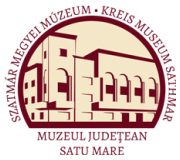Szőcs Péter Levente (szerk.): Călătorii istorice pe Valea Someşului. Ghid turistic (Satu Mare, 2014)
Crucişor
Crucisor J Traveling further to east, the traveler passes through Crucişor, Poiana Codrului and Iegherişte settlements. The first written document that mentioned Crucişor dates back to 1231. It was part of the Drágfi domain during the Middle Ages with its center at Beltiug. The Károlyi family owned it from the 18th century. A fortification with earthen walls, was identified on the Pintea Hill, near the settlement, but this is not linked dated to the hajdúk, but according tot archaeological researches made in the 1970s, it dates back to the early Middle Ages. On the top of the hill the ditch surrounding the castle is partially kept, with its width of 4 m and depth of 2,5 and 3 m. Through the archaeological excavations a row of was identified, which was part of the fortification, too. The Orthodox church, dedicated to the Three Archpriest was built in 1850. Iegherişte was mentioned for the first time in a 1272. It had the same history as Poiana Codrului during the Middle Ages and early-modern period, pre-modern times. In the 18th century, a glass factory was established here, bringing notoriety for the zone. The factory was moved to Poiana Codrului due to the exhaustion of local resources, a century later. The Orthodox church of Archangels St Michael and Gabriel was built in 1896. The settlement was the birth place of Florian Stan (1857-1925), auxiliary bishop of Greek-catholic diocese of Oradea. Poiana Codrului was mentioned in 1272 for the first time. During the Middle Ages it belonged to the Medieşu Aurit domain and later it was owned by the Károlyi family. The glass factory was moved from Crucişor, Cetatea Pintii • Borválaszút, Pintye-vár Secţiuni arheologice • Régészeti feltárás • Archaeological sections Poiana Codrului • Szelestyehuta Fabrica de sticlă • Üveggyár • Glass-factory 75
